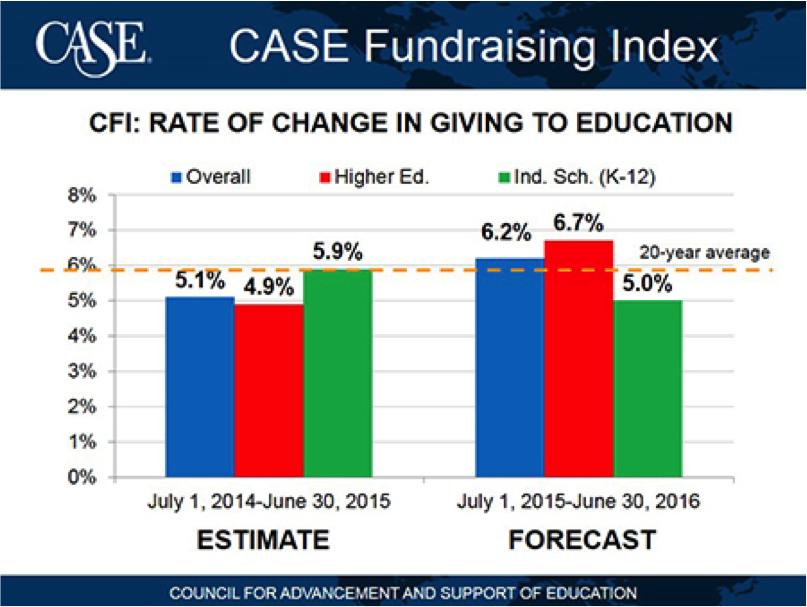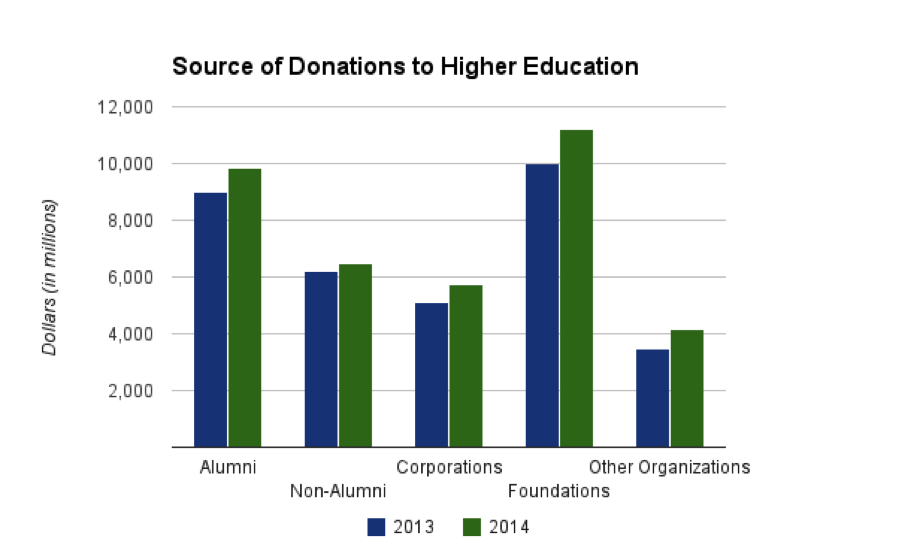Let the Good Times Roll: Campus Giving Keeps Rising (Along With Criticism)
/No, you're not imagining things: Giving to colleges and universities is still going up. With the Great Recession moving ever further into the rearview mirror, the economy continuing to gain steam, and stock portfolios flush from a long bull market, it's good times in campus development offices. What's more, the future looks pretty rosy, too.
That's the takeaway from a new study by theCouncil for Advancement and Support of Education(CASE), and it certainly tracks with the reporting we've been doing over the past year on a seemingly endless string of major gifts to higher ed institutions.
The CASE Fundraising Index (CFI) study, conducted twice every year, surveys senior-level fundraising and development directors at over 1,600 CASE-member institutions across the U.S.—including colleges and universities (public and private, two-year and four-year), and private independent K-12 schools—to estimate the level of charitable giving they received over the 12-month school year and to predict the level for the 12 months ahead. And according to the CFI, the 2014-2015 academic year saw overall charitable giving to educational institutions jump over 5 percent, with many predicting next year's numbers will be even higher.
According to CASE:
Fundraisers at independent schools estimated the greatest growth in giving for the 2015 academic year at 5.9 percent. Fundraisers at public and private higher education institutions estimated 4.8 percent and 4.9 percent, respectively, while community colleges estimated giving at 1.5 percent.
Looking forward, fundraisers at schools, colleges and universities predicted an increase of 6.2 percent in giving in the 2016 academic year. Public higher education institutions and community colleges were the most optimistic, predicting 8.3 and 9.2 percent increases in giving.
If numbers are more your thing, here’s a fun graph CASE released to put the data above into colorful numerical context:

Perhaps the most obvious conclusion here is that institutions of higher education have high expectations, and according to the Council for Aid to Education (CAE), rightfully so. In its Annual Voluntary Support of Education report, released by CAE earlier this year, charitable donations to colleges and universities in 2014 obliterated previous records, jumping 10.8 percent, totaling nearly $38 billion.
So where is all this money coming from? According to Inside Higher Ed, gifts from all sources, including alumni, corporations and private foundations, were up in 2014.
I know what you’re thinking. You want another graph. Well, today is your lucky day:

While the strongest support for higher education appears to come from alumni and foundations, alumni participation rates have actually been dropping steadily for the last 20 years.
So now that we know where the money is coming from, where is it going? Donations earmarked for student financial aid consistently make up the largest category of money donated, but not all charitable gifts come in the form of cash and prizes. Philanthropists like Eli Broad and Peter Norton, among many others, have famously donated valuable works from their personal art collections to colleges and universities in the past, but according to CAE Survey Director Ann Kaplan, these types of cultural bequests are on the rise.
In fact, one of the biggest gifts so far this year came in the form of a $300 million rare books collection given to Princeton.
Major giving to institutions of higher education is hardly news. But with a big portion of donations going to a small group of top-tier institutions—with Harvard, Stanford and USC rounding out the top three—major donors have faced criticism over what some see as a self-serving attempt to secure a lasting legacy among elite circles that has little to do with meeting any kind of "real" need.
We get that critique. Should some rich guy get a massive tax write off for donating books that students are unlikely to ever even touch? At time when Pell grants are being cut? Maybe not. But our overall view at IP is that these big campus gifts need to be analyzed one by one, and without jumping on any bandwagons. For example, we offered something of a defense of John Paulson's controversial $400 million gift to Harvard, saying that supporting science at a top research university was hardly an insane use of money—especially at a time that grants from the National Science Foundation are falling.
Related: Why That $400 Million Harvard Gift Isn’t Completely Crazy
More broadly, you can see the appeal to donors of getting behind well-respected institutions that produce the people and ideas that change the world. That's particularly true in contrast to the other major education philanthropy space—K-12 schools—a famously tough space for funders to score successes.
Related:








